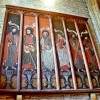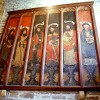Sea Fencibles? If you have never before heard of them, you are not alone. I was in the same position until recently when the subject cropped up during investigations into other matters, but once it is realised that the Fencibles were a short-lived kind of coastguard force of the Napoleonic period, this general ignorance is perhaps not surprising.
The “fencible” is an elision of “defensible” and the Sea Fencibles could be regarded in their day as the maritime equivalent of the Home Guard of the world wars, though formed in response to a threat of invasion by Napoleon some one-and-a-half centuries earlier than the formation of Dads Army. The Sea Fencibles were mostly volunteers living close to the coast who, we may imagine, were only too glad to accept a pay of a shilling a day in return for immunity from service in the militia or else being press-ganged into the navy. However the relative usefulness of the Fencible force has divided opinion among naval personnel and historians.
The Sea Fencibles were formed on May 14th, 1798 at the instigation of King George III. By 1801 Sea Fencible units had been established all along the coast from Whitby right into Cornwall, so Dorset would have had its own units by then. Across the county there were three units, the most easterly covering the length of coast from Calshot in Hampshire to St. Aldhelm’s Head in Purbeck, with one captain, four lieutenants and 482 men. The central unit extended from St. Aldhelm’s Head to Puncknowle, with seven officers and 284 men; the most westerly unit then extended from Puncknowle to Teignmouth in Devon, having eight officers and 331men.
There was no problem in obtaining volunteers, and Sea Fencibles could be recruited from fishermen, bargemen, farm labourers etc; many naval officers were also involved, since the navy had a surplus with no concept of retirement. These included Nelson himself, who briefly took command of a unit when in charge of the coastal defences. The recruits were trained in the use of cannon and pike.
A prior responsibility for these units was to signal the arrival of an enemy force approaching from the Channel, and to this end the most complicated and painstaking arrangements were worked out. If the alarm was raised the coast would have to be evacuated, with people, cattle, valuable goods and anything else of value to the enemy being moved inland. To ensure that this operation was carried out smoothly and that everyone knew where to go and by which route, very elaborate and detailed plans were drawn up. Interestingly Thomas Hardy describes just such an operation in his novel “The Trumpet Major.”
During the thaw in Anglo-French hostilities leading to the treaty of Amiens in 1802, a feeling among the high command that perhaps the Fencibles had outlived their purpose led to units being disbanded, though the annulment was destined to be short lived. The following year war broke out again, and a resumption of an invasion threat from Napoleon promptly brought the Fencible units back into service again once the press gangs had “re-stocked” the Navy with new personnel. The move was also to satisfy popular feeling, though many placed no confidence in the units. From 1803 the Fencibles were also given a more important offshore duty as enforcers of blockades on the English side of the Channel, using gunboats.
However, the resumption of the coastguard watch was not without its crop of bogus alerts. In May 1804 at the height of the invasion scare, the signal station on the Verne at Portland raised a false alarm during a blanket of thick fog that caused a wave of serious panic throughout the county. Serious, because none other than the king happened to be staying at Weymouth at the time! There was consequently serious concern for his safety, though of course this was unfounded.
About this time there was a return to the use of fire beacons, and it is noted that these warnings were set up on Ballard Down, Round Down, St. Aldhelm’s Head, Hamborough Hill, and the Verne. Nothe Fort, a circular brick-built redoubt at Weymouth, housed two traversing guns with platforms on either flank carrying two guns each (this artillery was removed in 1821.) Bridport possessed two batteries of two guns each, for which the emplacements had been built by the county. A magazine was constructed at Dorchester in 1809.
Other than this, information on the Dorset units during the second operational period is woefully lacking. There is also some discrepancy across various sources as to the actual year the Sea Fencibles were disbanded for the second and last time. One source states they were disbanded as early as 1810 which, exactly half-way between the time of Trafalgar and Waterloo, may be considered rather premature, even though the former victory put paid to any possibility of an invasion of England. The next date given is 1812 (the year of Napoleon’s rout at the Battle of Borodino in the Russian campaign,) which perhaps is more tenable, though the 1815 of a third reference, when Napoleon was forced into exile, would have to be the very latest date that a coast watch force would likely have been needed. Alternatively these differences could be explained if the disbanding was not a single event, but an incremental process in which individual units were simply disbanded at local level between the earliest and latest dates.



